
![]()
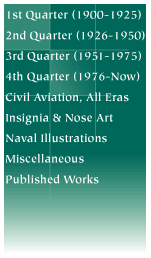
The Sopwith Aviation Company
By Bob Pearson
Of the many famous aircraft manufacturers in the period 1914-1918, one of the most recognizable names would have to be that bearing Thomas Octave Murdoch Sopwith's name. The Sopwith Aviation Company Ltd of Kingston-on-Thames was formed in 1912 and produced many outstanding designs prior to its demise in 1920, some of which are illustrated here.
Sopwith Schneider
A development of the pre-war Tabloid, the Schneider entered RNAS use in February 1915.
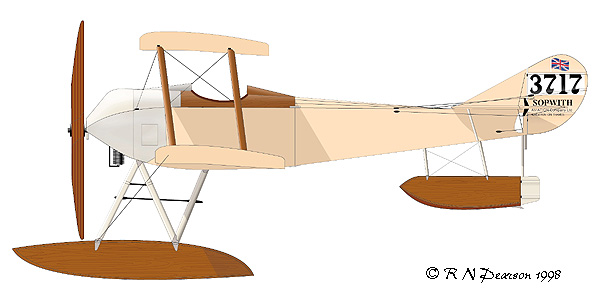
Sopwith Schneider 3717
FSL J. M. d'A Levy
Felixstowe NAS
August 1915
3717 was delivered to Felixstowe on 22 July 1915 and was flown by FSL J M Levy on anti-Zeppelin patrol. On 12 August 1915, Levy was shot down by AA after attacking Zeebrugge harbor and taken POW. 3717 was sunk and later salvaged by the Germans, ultimately being placed on display. The only national markings carried by 3717 were the small Union Jacks on the rudder.
Sopwith Baby
The next progression in the floatplane evolution was the Baby. This was basically a Schneider fitted with a Clerget (110 or 130hp) in a new horseshoe shaped cowl.
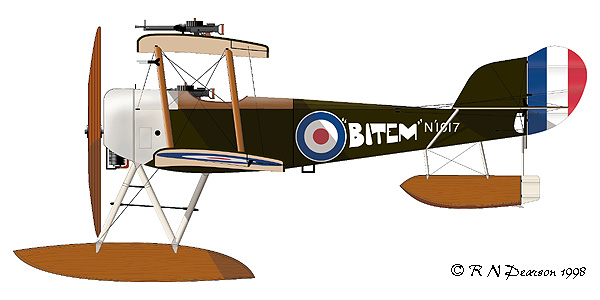
Sopwith Baby N1017
Dunkerque NAS
Summer 1917
N1017 arrived at the Dunkerque NAS on 31 May 1917 where it was given the name 'BITEM'. Note the Lewis machine gun alongside the cockpit fixed to fire through the propellor, plus the second one on the top wing to fire above the propellor arc.
Sopwith 1 1/2 Strutter
The first Sopwith design to see widespread service was the Land Clerget Tractor - better known as the 1 1/2 Srutter due to the arrangement of its cabane struts. The Strutter was produced in two variants: a single-seat bomber was used by the RNAS Wings as well as license-produced in France (in fact the French built more Strutters than the British); and a two-seat fighter which was used by both the RNAS and the RFC.
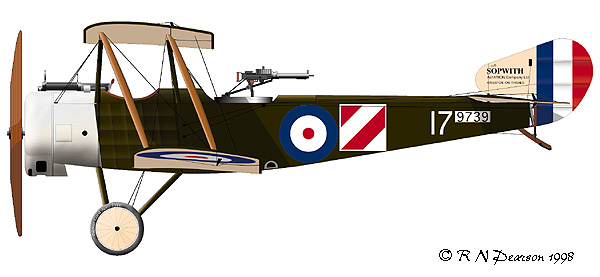
Sopwith 1 1/2 Strutter 9739
No. 3 Wing RNAS
Luxeuil-les-Bains Aerodrome
October 1916
A presentation aircraft named 'Britons in Egypt No. 2', 9739 went to No. 3 Wing RNAS, Manston on 28 August 1916, and arrived at Luxeuil-les-Bains on 22 September. On 25 February 1917, FSL L. E. Smith and AM R. S. Portsmouth were shot down by Off.Stv. Gottlieb Vothknecht of Jasta 24 for his first victory. Portsmouth was killed, while Smith was taken POW and later died of his wounds.
Sopwith Pup
"Good heavens, your aircraft has had a Pup!!" With these words a legend was born. The Sopwith Pup indeed appears to have been whelped from the 1 1/2 Strutter. Maneuverable and able to hold its height in a turn, the Sopwith Pup went on to become a firm favorite of both the RFC and the RNAS. The only drawback was its single gun. At a time that the German Albatros was mounting two Spandau machine guns the Pup only carried a single Vickers.
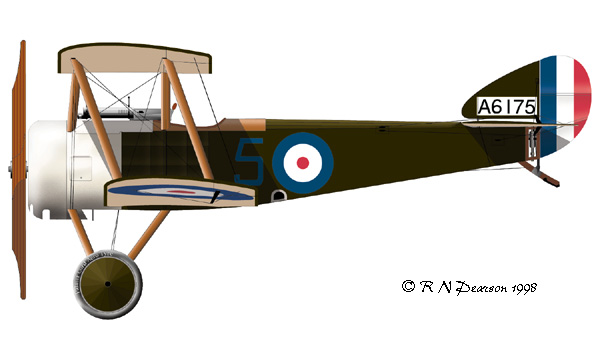
Sopwith Pup A6175
Lt. R. S. Capon
B Flight
No. 66 Sqn RFC
April 1917
On 24 April 1917, six Pups of No. 66 Sqn RFC were flying escort for nine Strutters of No. 70 Sqn when they were attacked by enemy aircraft. Lt. R. S. Capon in A6175 was shot down by Oblt Lorenz of Jasta 33 and taken POW. Capon had been the first combat loss for No. 66 Sqn.
Sopwith Triplane
"It seemed light and elegant and yet wiry... what it lacked in quickness it made up in the smoothness and grace of its movements. A Triplane looping looked like no other machine and gave the loops an individual quality. Irreverent pilots said it looked, when doing aerobatics, like an intoxicated flight of stairs..." so wrote Major Oliver Stewart of the Sopwith Triplane.
The Triplane was an attempt to improve on the Pup's already impressive performance by replacing the Pup's two wings with three wings of reduced chord but the same span, resulting in much more lift. The reduced chord also improved the pilot's visibility. Once again the only disappointing feature was the single Vickers - which in some cases was corrected by the fitting of a second gun. So successful was the Triplane that the Germans and the French set about emulating it.
The French with the Nieuport and the Germans with their Albatros Dr.I, Pfalz Dr.I, and the most famous of the lot, the Fokker F.I (later called the Dr.I) Triplane.
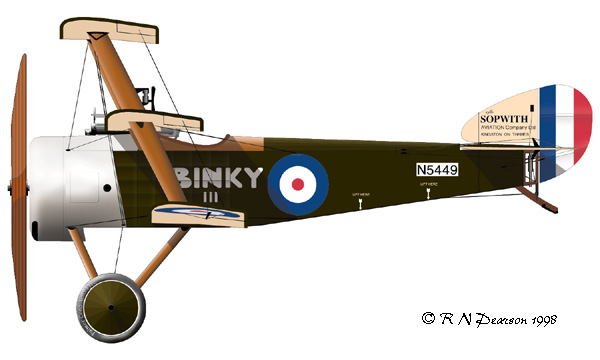
Sopwith Triplane N5449
No. 8(N) Sqn RNAS
April 1917
Arriving at 8(N) on 28 February 1917 and originally named JOAN, BINKY III was photographed on its back after being overturned on landing by FSL J. A. M. Allen on 15 March 1917. F/Cdr P. A. Johnstone sent a red and green Albatros down OOC on 3 May 1917. On 10 August, FSL E. D. Crundall was forced to land after being hit by ground fire and N5449 was then shelled for eight hours. After being repaired, N5449 went to 1(N) where it was flown by FSL Spence during which he scored two victories.
Sopwith Camel
When one thinks of First World War aviation, two aircraft types invariably come to mind. One has already been mentioned, while the other also shared the F.1 designation. The Sopwith Camel has come to symbolize (rightly or wrongly) the British fighter in WWI. Highly maneuverable and as deadly to the novice pilot as to the enemy, the Camel concentrated all its weight within the first seven feet of the fuselage. This resulted in a massive torque effect and made for very fast right hand turns. However in the hands of an inexperienced pilot this same responsiveness could be deadly and Camel accidents resulted in many deaths among its own pilots.
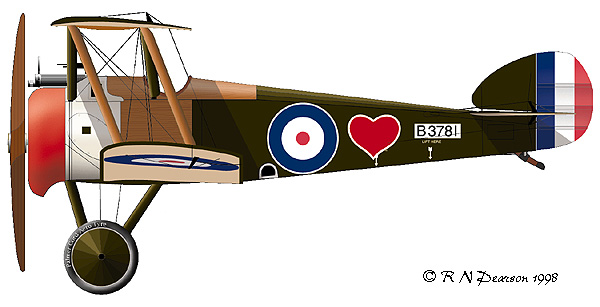
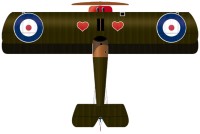 Sopwith
Camel B3781
Sopwith
Camel B3781
FSL J. W. P. Ellwood
No. 3(N) Sqn RNAS
August 1917
On 27 August 1917, FSL J. W. P. Ellwood of No. 3(N) Sqn RNAS crashed near St. Pol. After repair B3781 went on to 9(N) and 10(N) where it was lost on 18 March 1918 with FSL G. T. Steeves being taken POW. The top view is included to show the hearts repeated on either side of the center section. Although the cowl is depicted here as being red, it may have been black.
Sopwith 5F.1 Dolphin
The Sopwith Dolphin represented almost as radical a departure from standard Sopwith designs of the day as did the earlier Triplane. First off the Dolphin was powered by the Hispano-Suiza V-8 whereas most previous Sopwith designs made use of rotaries.
However the most obvious change was the position of the upper wing. In the Dolphin the wing was lowered and featured reverse stagger. This allowed for excellent upwards visibility, but caused concern in the event of overturning. After initial wariness, the Dolphin turned out to be an excellent high-altitude fighter. The Dolphin was also the first British multi-gun fighter with two fixed Vickers and two Lewis guns in the center section. Most, however, had just one Lewis.
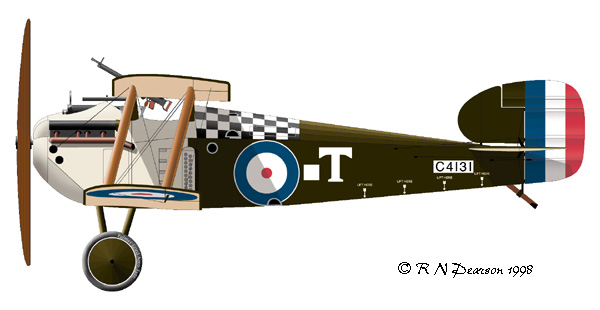
Sopwith 5F.1 Dolphin C4131
Captain William Mays Fry
OC C Flight
No. 79 Sqn RAF
May 1918
C4131 was flown by Captain W. M. Fry when he scored his 11th victory on 11 May 1918. Also flown by Lt. V. G. Snyder, C4131 featured a black and white checkerboard on the turtledeck.
Sopwith 7F.1 Snipe
The final Sopwith design to see widespread service was the 7F.1 Snipe. The Snipe returned to the tried and true rotary power that had served Sopwith so well, albeit the more powerful 230hp Bentley BR.2. By the Armistice of 11 November 1918, four squadrons had converted to the Snipe while postwar use saw 11 squadrons using the type.
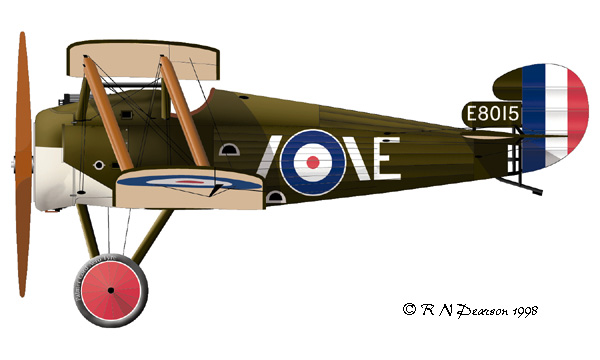
Sopwith 7F.1 Snipe E8015
Lt. Mulcair
A Flight
No. 43 Sqn RAF
October 1918
While flying E8015 Mulcair reportedly downed a Fokker D.VII on 30 Octover 1918, however RAF Communique No. 31 makes no mention of this, but does credit him with on in No. 27 as a shared victory with Lt. R. S. Johnston.